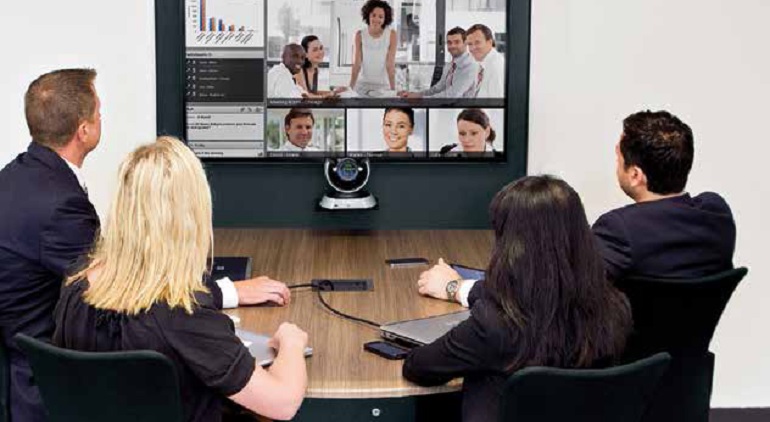Communication with remote employees, partners, and contractors is crucial for any organization. Over just a few years, videoconferencing has emerged and developed into a preferred way for businesses to collaborate across distances, increasing productivity and saving time.
“AV equipment should be stored in purpose-built collaboration furniture, credenzas, table pedestals, and lecterns with integrated cable management and cooling for the most streamlined, reliable installation,” according to Dean Wheelan, application specialist at Middle Atlantic Products. As videoconferencing has matured beyond its nascent beginnings into standalone platforms and a multitude of solutions, realism has become key to pulling off a successful videoconferencing system. Designing the optimal space, or retrofitting an existing room, is now as much accepted science as it is feng shui.
“The peripherals and especially the furniture selection and placement should be priorities from the onset of room design,” said Gina Sansivero, director of business development, education, at FSR.
“Determining the primary use of the space, [as well as] the size of the space and the room orientation, will guide the furniture selection and dictate the peripherals that will work best in that environment.”
All that design work and furniture selection must play to the camera; otherwise, it’s a wasted exercise. Camera placement, specifically, plays a pivotal role in how integrators can ensure a seamless, natural visual experience for the videoconferencing users.
“Ideally, you want the camera as eye-level as possible so it looks like you’re actually looking at a person on the far side [of the table], as opposed to just looking wherever the camera’s located,” said Aaron Rubner, vice president of sales at AVTEQ.
His colleague, regional sales manager Dee Dee DeVoe, agreed, adding, “It gives that more personal approach. You want to bring people into your collaboration space. You want to make sure you’re using the technology in the most beneficial way.”
Fortunately, there’s a method for figuring out the ideal camera height and placement. First, a camera must be placed as close as possible to the monitor screen that will display the other party’s conference room, so the participants appear to be looking directly at each other as they view them through the screen.
According to Dean Wheelan, application specialist at Middle Atlantic Products, the optimal camera height is between 42 and 52 inches from the floor level, based on the 95th percentile for seated eye height. Monitor placement is important, as well.
“The ideal size for a display in videoconferencing applications is determined by establishing the maximum comfortable video viewing distance within the room, which commonly is a factor of eight times the image height,” he added.
The type of room and its intended functions can lead integrators to determine how cameras can be used effectively. Small, huddle-style rooms can work well with bar-stool or counter-height seating, while traditional conference rooms are often outfitted with traditional 30-inch tables.
“Clearly camera angles can be adjusted,” said Sansivero, “but if they aren’t placed in the correct spot or angle from the beginning, it is irresponsible to think that your client is going to modify it to work properly.”
The shape of the furniture—especially the conference table—is just as important as where you place the pieces.
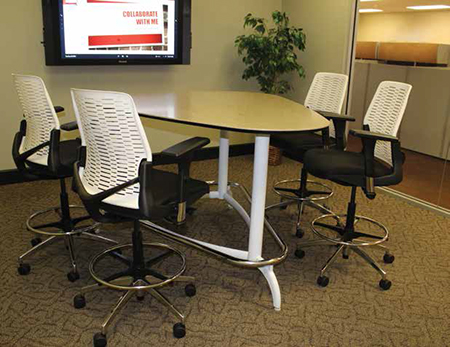
AVTEQ recently built a guitar pick-shaped table for a client to give participants the ability to be seen evenly and interact. “Table shapes that taper in a trapezoidal or V-shape are optimal for camera capture,” said Wheelan.
That’s because with a square or round table, noted DeVoe, people have to lean in or lean out to actually see what is on the screen. AVTEQ recently built a guitar pick-shaped table for a client to give participants the ability to be seen evenly and interact.
“But also we made it at bar-stool height, so you’re not being talked down to when you’re sitting at a table [while] someone is up there using a collaboration piece,” she said. “It’s eye-to-eye contact, it’s a huddle space, but very much designed around a whole collaboration solution, which is really an integral part of videoconferencing.”
Beyond cameras, integrators are absorbing the widely horizontal nature of the BYOD technology movement, as well as the challenges of wireless peripherals—scenarios that must be considered when designing or specifying a videoconferencing solution.
“The landscape for meeting spaces is evolving to incorporate technological advances that the AV industry continues to discover, and to accommodate the expectations of the changing demographics in the workplace with the increase of millennials,” Wheelan said.
“Trending now are all-in-one furniture solutions that meet the aesthetic demands of meeting room designers while providing discreet equipment mounting close to the point of use,” he continued. “AV equipment should be stored in purpose-built collaboration furniture, credenzas, table pedestals, and lecterns with integrated cable management and cooling for the most streamlined, reliable installation.”
In many cases, clients now want to get flexibility in addition to a room’s typical, or tailored, usage. With limitations inherent in a purposefully designed room, it’s best to know this as early as possible and to think a few steps ahead.
“The majority of the time, the room may be used for a specific purpose,” said Sansivero. “But sometimes that purpose may change. How do you make sure that the room works well for a variety of uses?”
Sansivero recommended placing user friendliness high on the list, with a deliberate placement of connectivity and power, and most of all, casters.
“If the room is going to be a flex room, make sure that the furniture is as easy to move and use as the equipment is to operate.”
Overall, function comes before form, whether the project calls for an ornate meeting space or a duck-in huddle room.
“I think integrators have to be more open minded to what the actual furniture in the space can do,” said DeVoe. “You want people to feel a part of the presentation, not being presented to, and [that takes] having the integrator understand how technology can support collaboration and how the furniture can be a part of that collaboration, as well.”
Jim Beaugez, APR, is a freelance writer and accredited communications professional with a decade of experience in the MI and pro audio industries. You can reach him at jimbeaugez@gmail.com and on Twitter @JimBeaugez.
AV Furniture
Salamander Design Low-Profile Cabinets

The What: Salamander Design has launched the Low Profile Wall Cabinets as part of its Chameleon collection. Measuring only 12 inches deep and available in an array of styles and configurations, these shallow-depth cabinets are designed make it easy to conceal AV electronics and wiring in an elegant, low-profile space.
The What Else: Salamander floor-standing shallow depth cabinets are designed to be easily affixed to the rear wall for added safety and stability, particularly when using the optional integrated TV mount that ideally positions almost any size flat panel display without the need to drill into finished wall surfaces. Each cabinet is constructed on a lifetime-warrantied extruded-aluminum frame that enables easy customization for just about any application. The chassis is also future-proof, accepting retrofit-able accessories to accommodate the evolving needs of each user.
The Bottom Line: The Low Profile Wall Cabinets are available in triple and quad-width sizes and can be configured to suit any need, to help provide AV specialists with a sleek, premium solution that will help differentiate themselves in a highly competitive market.
Bretford TechGuard Charging Lockers
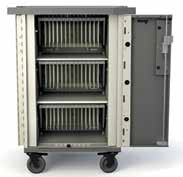
The What: The TechGuard Charging Lockers is a line of powered lockers for storing, securing, and charging laptops, tablets, and smartphones. Designed for use in education, retail, healthcare, and business environments, the TechGuard Charging Lockers are useful anywhere students, staff, customers, or visitors need to securely charge and store devices. Available in 1-, 5-, or 10-bay configurations, each bay can hold a 15.5-inch laptop, 10-inch tablet, and a phone, and the lockers are capable of charging them all simultaneously.
The What Else: Inside each of the lockers is one AC outlet and two USB charging ports, both capable of providing full-rate charging up to 2.4 Amps. The bays are illuminated by courtesy lighting when the door is open, simplifying the connection of devices while clear-view windows enable administrators to monitor the contents of the bays in shared environments. Each locker includes two administration cards for override access. The access cards open the locker for inspection while maintaining the current code, and the reset card opens them and resets the code. A keypad lock is powered by the internal system power supply, rendering batteries unnecessary and reducing maintenance time. If a power outage occurs, an optional JumpStarter accessory allows individual bays to be accessed via the existing passcode or administrator cards.
The Bottom Line: The steel chassis is available in platinum and can be customized and branded with school or corporate colors and logos. Heavy gauge steel and polycarbonate construction securely store devices. All components are accessible from the front of the unit. The TechGuard Lockers are UL 60950-1 listed for safety of IT equipment, FCC certified, and are pending Greenguard Gold indoor air quality certification.
Winsted Impulse Dual Sit/Stand
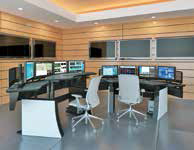
The What: Winsted’s new Impulse Dual Sit/Stand consoles take ergonomics and operator comfort to a new level by offering two independently adjustable, ergonomically curved work surfaces. These surfaces can be raised and lowered to meet the needs of individual operators while offering flexibility between sitting and standing.
The What Else: Both work surfaces are controlled by two electric-lift legs and adjust from 30- to 46-inches high at the touch of a button. The dual work surfaces feature a durable, high-pressure Graphite Nebula laminate with Safeguard Edge. For added versatility, all Impulse consoles come complete with Winsted’s Versa-Trak monitor mounting system, which supports various monitor arrays with versatile horizontal adjustment. Post-mounted VESA brackets provide vertical adjustments along with the ability to tilt and pivot monitors.
Electric-lift legs quickly and easily adjust the work surface height, offering three programmable height settings. Each work surface has a load capacity of 520 lbs. The CPU Pedestal mounts to the inside of the leg and features leg levelers and two slots for adjustable Velcro straps to keep the CPU safe and secure. A decorative, perforated privacy panel conceals cables and enhances the look of the console while adding privacy for the operator.
The Bottom Line: Easy-access cable management comes standard with a large cable channel incorporated into the modesty panel, as well as four vertical cable carriers that travel with the work surfaces. Three monitor mount post heights create monitor arrays suitable for any application, available in heights of 15 inches, 28.5 inches, and 42 inches. Optional decorative end panels are available in various colors. Winsted’s TruForm end panels complete the console look. Custom order options with laminate and solid-surface materials are also available. Durable black powder-coat paint accentuates the work surface, and the textured finish prevents fingerprints.
Marshall ELCO-VC

The What: This highly engineered, ventilated rack cabinet accommodates the audio, video, and codec of choice for conference room system configurations. Its open back allows for access to existing wall power infrastructure, and its floor has three cable entry points. The front includes a panel that is removable to gain entry to the internal equipment storage.
The What Else: Used as a stand alone piece of furniture, it can be attached securely to the wall with a hanging cleat or sit on leveling feet. On the top of the rack, there is ample room for a camera with cabling access, as well as optional wire chase that allows for hiding monitor cabling in the cabinet.
The Bottom Line: Standard finish is white melamine, but it is also available in other stock melamine colors, primed for on site painting, wood veneers, and high pressure laminates. Ships fully assembled with a 10-year warranty.
HSA Specialized Technical Furnishings
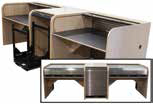
The What: HSA creates specialized technical furnishings to contain the audio, video, computer and control systems that are so much a part of today’s education, house of worship and civic environments. Lockable, easy to operate from, and aesthetically designed, HSA Rolltop Desk control centers ergonomically blend the mixers, controllers, and video displays during use while protecting them when not in use.
The What Else: They are available in many configurations and options, including with stainless steel rolltop tambours, compliant, institutional grade locks, premium real wood veneers in combination with high-pressure laminates, and more.
Spectrum Media Manager Series Lecterns

The What: Spectrum Industries presents the newly redesigned Media Manager Series of lecterns, suited to match décor while incorporating all AV and technology needs. This family of lecterns has a classic, elegant appearance, built with heavy-gauge steel. They are available with a flat surface, surround, or with an Overbridge Control Console for easy control access. Each lectern also has a removable rack cube, which can be shipped separately for easy AV and IT integration.
The What Else: The lecterns in this family also have their own unique features that set them apart from each other. The Director Lectern is the largest in the series and fits two full sized rack cubes for maximizing AV and technology integration. Protected with a dual-bolt lock, the Elite Lectern features a large document camera drawer placed at writing position and can be positioned either on the right or left side. The Link Lectern comes in an optional 36- or 41-inch height to suit the needs of specific functions and designs. The smallest in the family, the Compact Lectern still offers great integration but in a footprint that will fit the tightest spaces.
The Bottom Line: The Media Manager Series can be ordered in the Spectrum Expressions line of laminate and metal colors, which are designed to match Spectrum furniture to a room décor. The metal colors provide a tough, wear-resistant finish to metal parts. The laminates cover all worksurfaces and the matching vinyl edge trim provides the appearance of elegant custom-built furniture. The Media Manager Series is designed, assembled, and shipped from Spectrum’s factory in Chippewa Falls, Wisconsin. It is warranted to be free of all defects in materials and workmanship for 10 years.
